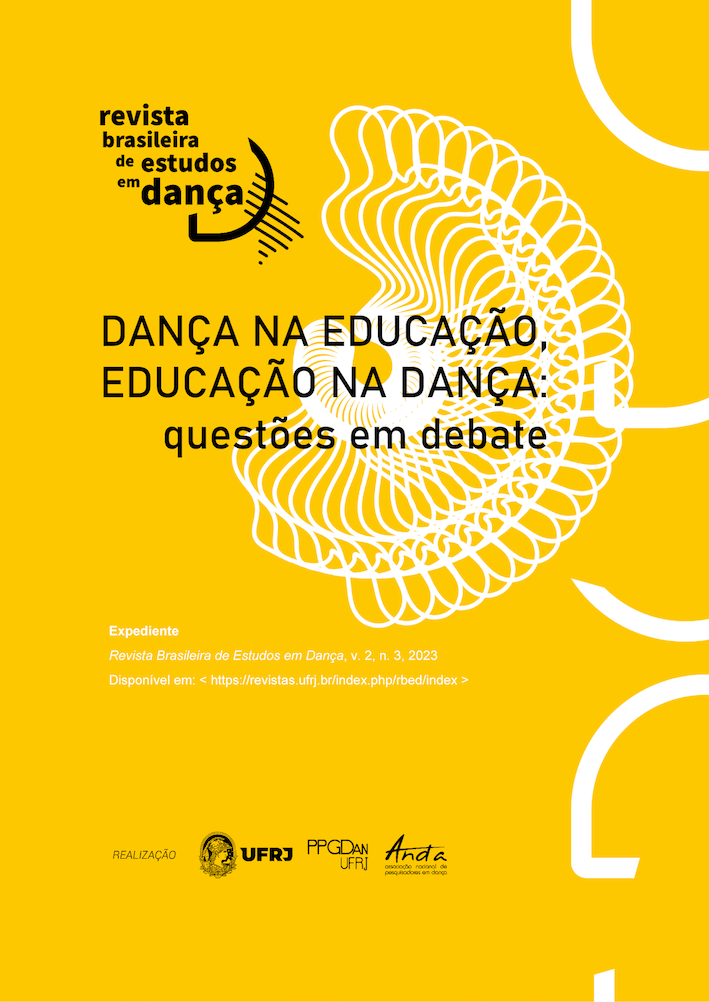Clues for dance compositions in education
DOI:
https://doi.org/10.58786/rbed.2023.v1.n3.58737Keywords:
dance, Education, clues, school.Abstract
Dance is an aesthetic practice, and, as such, it needs to be felt, much more than understood. By considering this premise and the danger of content and technical teaching approaches, which focus on what dance is, to the detriment of what this practice can become and change itself, this article aims to expose the inappropriateness of rules and universal principles of action, as the subject is dance in education. That is due to the affirmation of moving intentions and directions that only come together in action, within school educational relationships. Therefore, the question is: how to sensitize educators to these intentions and moving directions in the work involving school dance? Based on this question, some clues are presented, understanding them as ludic and groping guidelines that invite us to operate, always and every time, a methodological inversion for the teaching of dance in education.
Downloads
References
ALVES, Flávio Soares; COUTO, Yara Aparecida. Reflexões sobre Dança na Educação Física Escolar. Motricidades: Revista da Sociedade de Pesquisa Qualitativa em Motricidade Humana. [S. l.], v. 4, n. 3, p. 311-320, 2020. Disponível em: https://www.motricidades.org/journal/index.php/journal/article/view/2594-6463-2020-v4-n3-p311-320. Acesso em: 10 jul. 2023.
ANDRADE, Carolina Romano de. A Experiência em Dança: corpo, tempo e educação. In: GODOY, Kathya Maria Ayres de. Estudos e abordagens sobre metodologias de pesquisa e ensino: dança, arte e educação. Curitiba: Appris, 2020, p. 27-39. v.1.
BRASIL. Ministério da Educação. Base Nacional Comum Curricular. Brasília: MEC, 2018.
BUTLER, Judith. Vida Precária: os poderes do luto e da violência. Belo Horizonte: Autêntica Editora, 2019.
CAMPOS, Rosânia; SILVEIRA-BARBOSA, Maria Carmen. BNCC e educação infantil: quais as possibilidades? Retratos da Escola. Brasília, v. 9, n. 17, p. 353-366, jul./dez. 2015. Disponível em: https://retratosdaescola.emnuvens.com.br/rde/article/view/585/659. Acesso em: 02 mai. 2023.
CATALÃO, Marcos Aurélio Pinotti. Antologia e tradução comentada da obra poética de Antonio Machado. 2002. 345pgs. Dissertação (Mestrado em Teoria e História Literária) Instituto de Estudos da Linguagem, UNICAMP, Campinas. 2002.
MOURA-CARDILO, Camila. Dança e educação antirracista: juventude, diversidade e possibilidades. Diversidade e Educação. [S. l.], v. 9, n. 2, p. 772-790. 2021. Disponível em:https://repositorio.furg.br/bitstream/handle/123456789/10770/772-790%20DAN%c3%87A%20E%20EDUCA%c3%87%c3%83O%20ANTIRRACISTA.pdf?sequence=1&isAllowed=y. Acesso em: 02 mai. 2023.
DELEUZE, Gilles e GUATTARI, Félix. Mil platôs: capitalismo e esquizofrenia. Rio de. Janeiro: Editora 34, 1997. v. 5.
DELEUZE, Gilles. Nietzsche e a Filosofia. São Paulo: Editora N-1, 2018.
FOUCAULT, Michel. A ordem do discurso. 16ª ed. São Paulo: Loyola, 2008.
FOUCAULT, Michel. O cuidado com a verdade. In: ESCOBAR, Carlos Henrique (org.). Michel Foucault (1926-1984) – O Dossier: últimas entrevistas. Rio de Janeiro: Taurus, 1984.
GERHES, Adriana de Faria. As danças nas escolas: uma travessia entre os contextos e as experiências. Pensar a Prática, Goiânia, v.23. 2020. Disponível em: https://revistas.ufg.br/fef/article/view/55800. Acesso em: 10 jul. 2023.
LABAN, Rudolf. Domínio do Movimento. 3ª.ed., São Paulo: Summus, 1978.
LABAN, Rudolf. Dança Educativa Moderna. São Paulo: Ícone, 1990.
LARROSA-BONDÍA, Jorge. Notas sobre a experiência e o saber da experiência. In: Revista Brasileira de Educação. Rio de Janeiro, n. 19, jan/abr, p. 20-28, 2002. Disponível em: https://www.scielo.br/j/rbedu/a/Ycc5QDzZKcYVspCNspZVDxC/?format=pdf&lang=pt Acesso em: 10 jul. 2023.
MARQUES, Isabel Azevedo. Interações: crianças, dança e escola. São Paulo: Blucher, 2012a.
MARQUES, Isabel Azevedo. Dançando na escola. 6ª ed. São Paulo: Cortez, 2012b.
MAUSS, Marcel Sociologia e Antropologia. São Paulo: Cosac & Naify, 2003.
MOREIRA, Antônio Flávio e CANDAU, Vera Maria (orgs.). Multiculturalismo: diferenças culturais e práticas pedagógicas. 2ª. ed. - Petrópolis, RJ: Vozes, 2008.
NIETZSCHE, Friedrich. Ecce Homo. São Paulo: Martin Claret, 2003.
NIETZSCHE, Friedrich. A vontade de poder. Rio de Janeiro: Contraponto, 2008.
PASSOS, Eduardo, KASTRUP, Virgínia, ESCÓSSIA, Liliana. (orgs.). Pistas do método da cartografia: pesquisa intervenção e produção de subjetividade. Porto Alegre: Sulina, 2009.
POMBO, Catarina O corpo da estética: arte e natureza em Gilles Deleuze. In: LINS, Daniel; GADELHA, Silvio (orgs.). Nietzsche e Deleuze: que pode o corpo. Rio de Janeiro: Relume Dumará; Fortaleza, CE: Secretaria da Cultura e Desporto, 2002, p. 37-48.
RESENDE, C. A Escrita de um corpo sem órgãos. In: Fractal Revista de Psicologia, v. 20, n. 1, p. 65-76, Jan./Jun. 2008. Disponível em: https://www.scielo.br/j/fractal/a/SscLsWpBKRyzRPQLZq3mMNQ/?lang=pt Acesso em: 10 jul. 2023.
SENNETT, Richard. Juntos: os rituais, os prazeres e a política da cooperação. Rio de Janeiro: Record, 2012.
STECANELA, Nilda. A Coisificação da Relação Pedagógica no Cotidiano Escolar. In: Educação e Realidade. Porto Alegre, v. 43, n. 3, p. 929-946, jul./set, 2018. Disponível em: https://www.scielo.br/j/edreal/a/8RNmtMBZLRwTxtpRbWHvWGj/# Acesso em: 10 jul. 2023.
SOUSA, Nilza Coqueiro Pires; HUNGER, Dagmar Aparecida Cynthia França. Ensino da dança na escola: enfrentamentos e barreiras a transpor. Educación Física y Ciencia, Buenos Aires: Universidad Nacional de La Plata, v. 21, n.1, jan./mar. 2019. Disponível em: http://www.scielo.org.ar/pdf/efyc/v21n1/2314-2561-efyc-21-1-e070.pdf. Acesso em: 03 mai.2023.
TONDIN, Beatriz; BONA, Bruna Carolini. A dança e seu espaço na escola: educação física ou artes? Kinesis, [S. l.], v. 38, p. 01-14, 2020. Disponível em: https://periodicos.ufsm.br/kinesis/article/view/25195. Acesso em: 10 jul. 2023.
Downloads
Published
Versions
- 2024-05-09 (3)
- 2023-12-01 (2)
- 2023-09-02 (1)
How to Cite
Issue
Section
License
Authors who publish in the Revista Brasileira de Estudos em Dança are
responsible for the content of signed articles and retain copyright.
They grant the journal the right of first publication with the work simultaneously
licensed under the Creative Commons Attribution-NonCommercial 4.0 License
(Open Archives Initiative - OAI). This feature, used for open-access journals,
allows sharing work for non-commercial purposes and acknowledges
authorship. If the text is later published in another vehicle, the author
must inform that it was initially published as an article in the Revista Brasileira
de Estudos em Dança. Therefore, even if the journal owns the first publication,
authors are entitled to publish their work in institutional repositories or on
their personal pages, even if the editorial process has not been completed.
The journal reserves the right to make normative, orthographic, and grammatical changes to maintain the language standard, respecting the authorial style.

